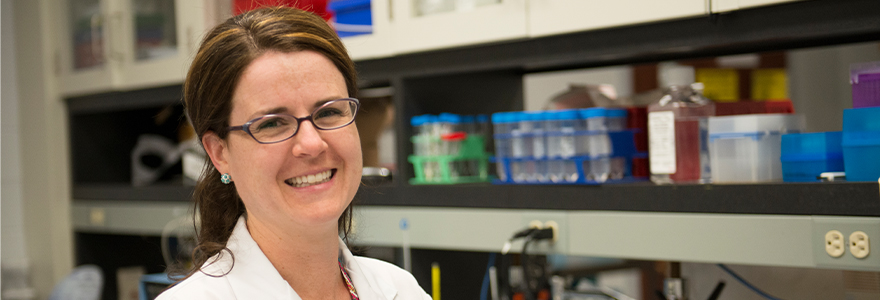Schulich Medicine researchers shed light on symptoms of understudied spine disease

Cheryle Séguin and her team are breaking new ground on an understudied disease
By Crystal Mackay
After hearing first-hand from patients about how the disease affected their lives, a team of researchers and graduate students at Western were inspired to investigate the symptoms associated with an understudied spine disease called diffuse idiopathic skeletal hyperostosis (DISH).
Prior studies suggested DISH affects up to a third of men over the age of 50. This non-inflammatory type of arthritis is characterized by the progressive calcification of spinal tissues that eventually leads to the fusion of the vertebrae within the spine. However, whether this calcification causes pain, especially in the early stages of the disease, isn’t well understood or well documented.
“We were hearing from patients that they were increasingly frustrated by descriptions of the disease as asymptomatic, when that wasn’t at all their lived experience,” said Cheryle Séguin, Schulich School of Medicine & Dentistry associate professor and lead author on the study.
“We wanted to see, using the tools in our lab, if we could better understand how pain and physical disability are associated with the progressive spine calcification that happens in this disease.”
Using a mouse model, the team demonstrated in a study recently published in the journal Arthritis Research & Therapy that even in the early stages of the disease, there was evidence of back stiffness and pain.
These results are the first evidence of impaired physical function, axial stiffness and pain associated with spine calcification in mice. The researchers say it underscores the need for pain to be evaluated in people living with DISH through the progression of spine calcification, with emphasis on the early stages of the disease.
“What we hope is that it inspires other researchers to ask similar questions in patients, which we think is really important,” said Séguin.
Despite the prevalence of DISH and the fact that it has been shown in the literature as an incidental finding on x-rays for close to 100 years, there are currently no disease-modifying treatments for it, and very little research to help characterize the disease or to inform treatment.
To complicate matters further, the spine calcification associated with DISH occurs progressively over an extended period of time, often beginning decades before a person is diagnosed.
When Séguin and her team first began studying DISH, they heard from patient groups who were desperate for answers. These patients worked with PhD students Dale Fournier and Matthew Veras in Séguin’s lab to inform the study design and shape the research question.
“Having those face-to-face interactions helped us better understand the impact of this disease on people’s lives,” said Fournier, a PhD candidate in Health Sciences and co-author on the study. “They told us first-hand what their experience was like and pain was largely a driving factor.”
Now that the team has been able to demonstrate in a mouse model the association between DISH and pain, they are hoping these findings can be translated to or motivate human studies that would ultimately help people with DISH.
“We hope that this study opens the door for therapeutics companies to test their compounds in this mouse model with the ultimate goal of bringing therapies to DISH patients in need,” said Veras.
The study was funded by the Arthritis Society of Canada and the Canadian Institutes of Health Research.








